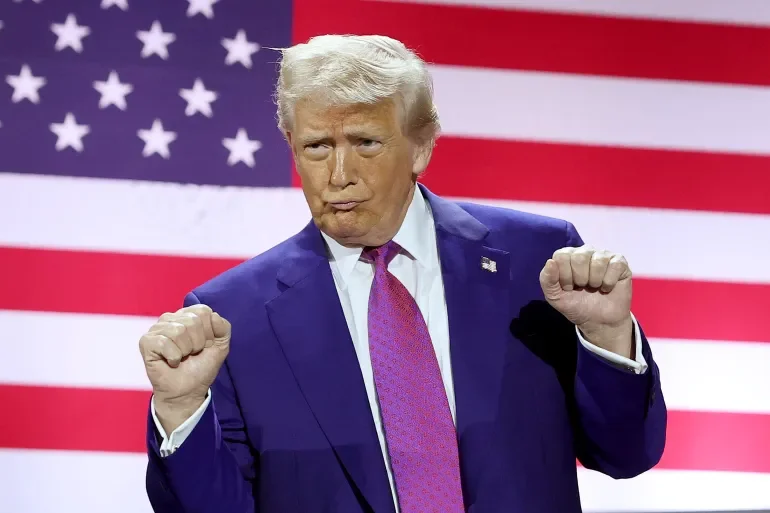Is Donald Trump a Fascist? A Plain-Language Guide to the Evidence
49% of Americans told CBS they believe Donald Trump is a fascist. That’s a big claim. So let’s set feelings aside and look at the core traits of fascism—how it operated under Hitler (Germany), Mussolini (Italy), and Franco (Spain)—and compare those traits to Trump’s words, actions, and governing style.
This isn’t about left vs. right. It’s about whether a leader’s behavior lines up with a historically recognized pattern.
What Is Fascism, in Practice?
Fascism isn’t just “being authoritarian.” It’s a bundle of habits and tactics that show up together:
1. Racial Hierarchy & Scapegoating
Classical fascism elevates a “pure” in-group and dehumanizes an “out-group.”
Nazi Germany exalted “Aryans” and labeled Jews, Slavs, and others as subhuman.
Trump’s rhetoric repeatedly casts immigrants—often Brown and Black people—as “animals,” “not human,” “poisoning the blood,” and a national threat. The point isn’t policy debate; it’s dehumanization to justify harsh measures.
2. Cult of the Leader
The leader is infallible; only he can fix it.
Hitler/Mussolini/Franco cultivated personal worship.
Trump frames himself as the singular problem-solver, demands personal loyalty, and places himself above party and process.
3. Mythic Past
“Make the nation great again” by returning to a purified, nostalgic era.
Fascists mythologized an idealized past to erase complexity and blame “others” for decline.
Trump’s revivalist narrative centers a white, male-dominated, Christian America of the 1950s—portraying today’s pluralism and dissent as corruption.
4. Political Violence—Encouraged or Excused
Street intimidation, paramilitaries, and punishment of enemies.
Nazis unleashed brownshirts; fascists normalize violence as politics.
Trump applauded or winked at violence (rally remarks about “knocking heads,” minimizing Jan. 6, promising legal cover), and sought military force against domestic dissent. Violence is reframed as “defense.”
5. Election Denial & Reality Reversal
If you lose, declare victory and claim betrayal.
Hitler lied about electoral outcomes and blamed enemies.
Trump’s 2020 “stolen election” narrative mirrors this tactic: negate facts, sustain grievance, and mobilize anger.
6. Enemies List & Purge Mentality
Divide the nation into loyalists and “traitors.”
Fascists targeted Jews, leftists, unions, LGBTQ+ people, the disabled, and minorities.
Trump’s politics fixate on enemies—immigrants, the “deep state,” the press, universities—fueling a permanent us-vs-them emergency.
7. Anti-Intellectualism & Cultural Control
Attack universities, museums, press, research—any institution that challenges the leader’s narrative.
Fascists rewrote history and censored culture.
Trump world seeks to bend curricula, public media, and cultural institutions to a preferred storyline, minimizing injustices (e.g., slavery’s brutality) and punishing dissenting voices.
8. Undermining Checks and Balances
Courts, independent agencies, the civil service, and legislatures are obstacles to be ignored or captured.
Fascists hollowed out institutions to remove constraints.
Trump routinely pressured the judiciary, DOJ, and Congress, and elevates personal loyalty over rule-of-law norms.
9. Militarized Masculinity & Misogyny
Glorification of dominance; women’s rights curtailed; sexual aggression excused.
Central in European fascism’s culture.
Trump’s rhetoric and entourage celebrate a macho, punitive politics that sidelines women and rewards abusers.
10. Fusion with Big Business
Regime and industry enrich one another while weakening labor, regulation, and accountability.
European fascism thrived on corporate complicity (armaments, chemicals, banking).
Trump’s policy agenda—deep deregulation, fossil-fuel favoritism, targeted tax cuts—rewards aligned sectors. Donor meetings and policy quid pro quos blur public interest with private gain.
11. Economy of Lies
Rewrite history and statistics to sustain the myth of victimhood and salvation.
Fascists recoded national crises as conspiracies by “enemies.”
Trump’s claims about elections, crime, the economy, and immigration persist despite contrary data—because the narrative is the tool.
So…Does Trump Fit the Pattern?
Measured against the checklist above, many pillars of fascist practice are present in Trump’s rhetoric and approach: dehumanization, cult of the leader, mythic past, validation of political violence, election denial, attacks on institutions, patriarchal machismo, corporate fusion, and systematic lying.
Reasonable people can debate degree and labels. But if the question is whether the distinctive pattern of fascism is visible, the evidence is substantial.
Why This Matters (Beyond Labels)
Fascism isn’t a switch that flips overnight; it’s a slope—normalized one speech, one purge, one rule-break at a time. The antidote isn’t panic; it’s civic muscle:
Defend institutions (independent courts, local election officials, a free press).
Refuse dehumanization—of anyone.
Reject political violence outright.
Insist on facts (even when they’re inconvenient).
Follow the money between policy and corporate beneficiaries.
Show up: vote, volunteer, testify, organize.
Democracy doesn’t survive on autopilot. It requires citizens who can recognize the pattern—and choose against it.
